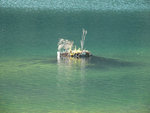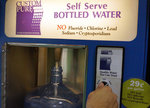The City of Port Townsend last week prepared for a possible emergency distribution of bottled water after initial testing found potentially toxic blue-green algae in the city's untreated source …
This item is available in full to subscribers.
We have recently launched a new and improved website. To continue reading, you will need to either log into your subscriber account, or purchase a new subscription.
If you had an active account on our previous website, then you have an account here. Simply reset your password to regain access to your account.
If you did not have an account on our previous website, but are a current print subscriber, click here to set up your website account.
Otherwise, click here to view your options for subscribing.
* Having trouble? Call our circulation department at 360-385-2900, or email our support.
Please log in to continue |
|



The City of Port Townsend last week prepared for a possible emergency distribution of bottled water after initial testing found potentially toxic blue-green algae in the city's untreated source reservoirs.
Subsequent tests revealed no toxins, and no public health warning has been issued.
Although bacteria found in lake algae has been a health concern in East Jefferson County since two dogs died after drinking from Anderson Lake in 2006, it previously had never been detected in the public water supply from Lords Lake or City Lake, according to David Timmons, city manager of Port Townsend.
City officials learned Sept. 15 that blue-green algae had been detected in the reservoir lakes during routine testing. The general public was not notified until Sept. 23, although the city had begun making emergency plans to distribute bottled water in the event any algal toxins were found.
"We didn't want to yell 'fire' in a crowded theater," Timmons said about why the city did not initially send a general public alert, pending more in-depth water testing.
"I have a compromised immune system myself, and I was told it was fine to keep drinking the water," he noted.
Andy Anderson, assistant regional manager for the state Department of Health's (DOH) Office of Drinking Water, said in a Sept. 24 email that test results were necessary before an accurate public alert could be delivered.
"Once we understood the situation and the risks, we informed the public," Anderson said of the Sept. 23 public announcement.
Ian Jablonski, city water quality manager, said the recorded algae cell count was 8,900 cells per milliliter in the untreated source water of City Lake, with lower levels in Lords Lake. An algal level of more than 2,000 cells per milliliter triggers follow-up testing to check for toxins. But according to EPA guidelines, cell counts below 20,000 cells per milliliter present a low relative probability of acute health effects, indicating that the risk of actual health effects remained low.
The algae arose at the city's two untreated reservoirs, not in treated tap water. When full, Lords Lake contains about 570 million gallons, and City Lake contains about 140 million gallons.
According to Anderson, the city is collecting samples twice a week from Lords Lake, City Lake, at the system inter-tie, and at the entrance to the city’s distribution system. DOH believes those locations provide an adequate representation of the water entering the treatment process. In response to concerns that sampling might miss toxins, Anderson replied that, "Because of long transmission lines and excellent mixing, sampling twice a week at representative points within the water system should provide an accurate indication of whether or not toxins are present."
According to Timmons, the city's new water treatment plant, expected to go into service in mid-October, contains a purpose-built additional port for adding potassium permanganate, which is effective at oxidizing algal toxins that are not neutralized by chlorine. The new membrane filtration process is designed to remove all organic material, including algae, but does not remove toxins. Anderson says the city’s new treatment plant will "provide significantly more protection than the current treatment plant" against the threat of algal toxins entering the water supply.
According to Anderson, home filtration systems using activated carbon or reverse osmosis can be effective in removing algal toxins, if the filter is properly maintained. Filters can hold toxins, and should be discarded after the toxic event is over. Anderson cautions that most point-of-use water filtering devices have not been evaluated by independent testing agencies for their ability to remove algal toxins.
In 2014, the city of Toledo, Ohio, experienced a toxic algae bloom event that resulted in a "do not drink" advisory, and Toledo city officials have since instituted a water quality "dashboard" and frequently asked questions page; see that information with this story on
ptleader.com.
WATER TESTING
Timmons said customer complaints about taste and odor are common at this time of year, as lake levels are typically drawn down, and months of warm temperature usually cause algae levels to rise. Unlike last year during the record drought, the city's reservoir system was not low at the beginning of September.
The City of Port Townsend Water Quality Department performed routine water sample testing on Sept. 15. Those preliminary tests confirmed the presence of blue-green algae in both Lords and City lakes, but locally available testing could not detect whether toxins were actually present.
Jablonski told the Leader that initial water samples were sent to a Seattle lab on Monday, Sept. 19. When the city learned that test results would not be available until Sept. 23, state DOH helped locate a different lab that could respond in a shorter time frame, and additional samples were sent to this second lab on Tuesday, Sept. 20. The expedited lab results, received on Wednesday, Sept. 21, confirmed that no toxins were present. Two sets of follow-up samples were returned Sept. 23, and also showed no toxins present, according to the state DOH.
"The city will continue to monitor for algae and algal toxins in Lords Lake and City Lake and in the drinking water until such time as the tests show that the algae blooms have dissipated," said Jablonski.
City water customers with questions may call 379-5001.
EMERGENCY PLAN
Throughout last week, the city reached out to Jefferson Healthcare, the Jefferson County Department of Emergency Management and Jefferson County Public Utility District (PUD), and began pulling together plans for possible bottled water distribution points as a short-term alternative.
As part of emergency management efforts, the county activated its neighborhood network, notifying neighborhood leaders, the ham radio network and other emergency response volunteers. This emergency network outreach is how the water question became more widely known.
The matter was also briefly discussed at the Sept. 20 PUD commission meeting, after the city reached out to the PUD as a potential alternative water source.
At the Sept. 20 meeting, PUD Manager Jim Parker brought the matter to the board's attention, stating that the city had called him to inquire about the possibility of obtaining water from PUD sources if emergency measures were required. Parker noted that the potential for toxin contamination was "not something [the city is] putting out to the public." The PUD does not currently have the capability of "cross-connecting" to the city's water distribution system, according to Timmons.
County emergency management had identified several sites around town where bottled water could have been distributed if actual toxins had been found in the public water supply. The preliminary sites identified for water distribution were Mountain View Commons, the fairgrounds and East Jefferson Fire Rescue station on Jacob Miller Road.
City and county officials are viewing this event as a good opportunity to test emergency preparedness, and are making more detailed plans to better handle future water quality events.
Anderson, in response to public inquiries about the situation, indicated the appropriate steps were followed. "The Department of Health worked with the city to evaluate the risks and get the information to the public as soon as possible. Since the evening of Thursday, Sept. 15, we’ve been working behind the scenes, pulling together industry experts, preparing for a rapid, effective response in the event of a real public health risk," Anderson said in a Sept. 24 email.
LAKE TESTING
Blue-green algae (technically a photosynthetic bacteria, Microcystis aeruginosa) has the potential to create toxins in water, posing a serious potential health risk, particularly for people with compromised immune systems.
It's been a health concern in East Jefferson County since 2006, when two dogs died after drinking water from Anderson Lake, 8 miles south of Port Townsend. Algae blooms have been a consistent issue at Anderson Lake ever since, curtailing fishing and on-water activities. Two popular freshwater swimming holes, Gibbs Lake and Lake Leland, have also had regular warm-weather problems with algae.
Jefferson County Public Health (JCPH) began lake monitoring in 2007. According to the JCPH website, tests from Aug. 15, 2016 indicate that Anderson Lake remains closed due to algae issues, while Gibbs and Leland are open with a "caution" label, which means not to swim in areas of scum (risking so-called "swimmer's itch"), or allow pets or livestock to drink lake water.
The hot summer of 2015 was particularly bad for algae blooms, with 10 lakes in Washington identified as problem areas, including Gibbs and Anderson. The algae problem was not widespread in the summer of 2016.
(Leader staff writers Allison Arthur and Patrick J. Sullivan contributed to this story.)
NOTE: Story corrected on Sept. 29 to show that PUD meeting comments were from Jim Parker, PUD manager, and not Ken Collins, PUD commission.